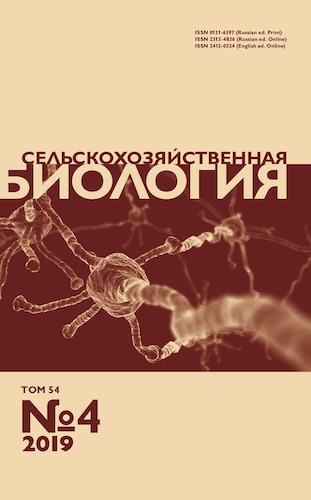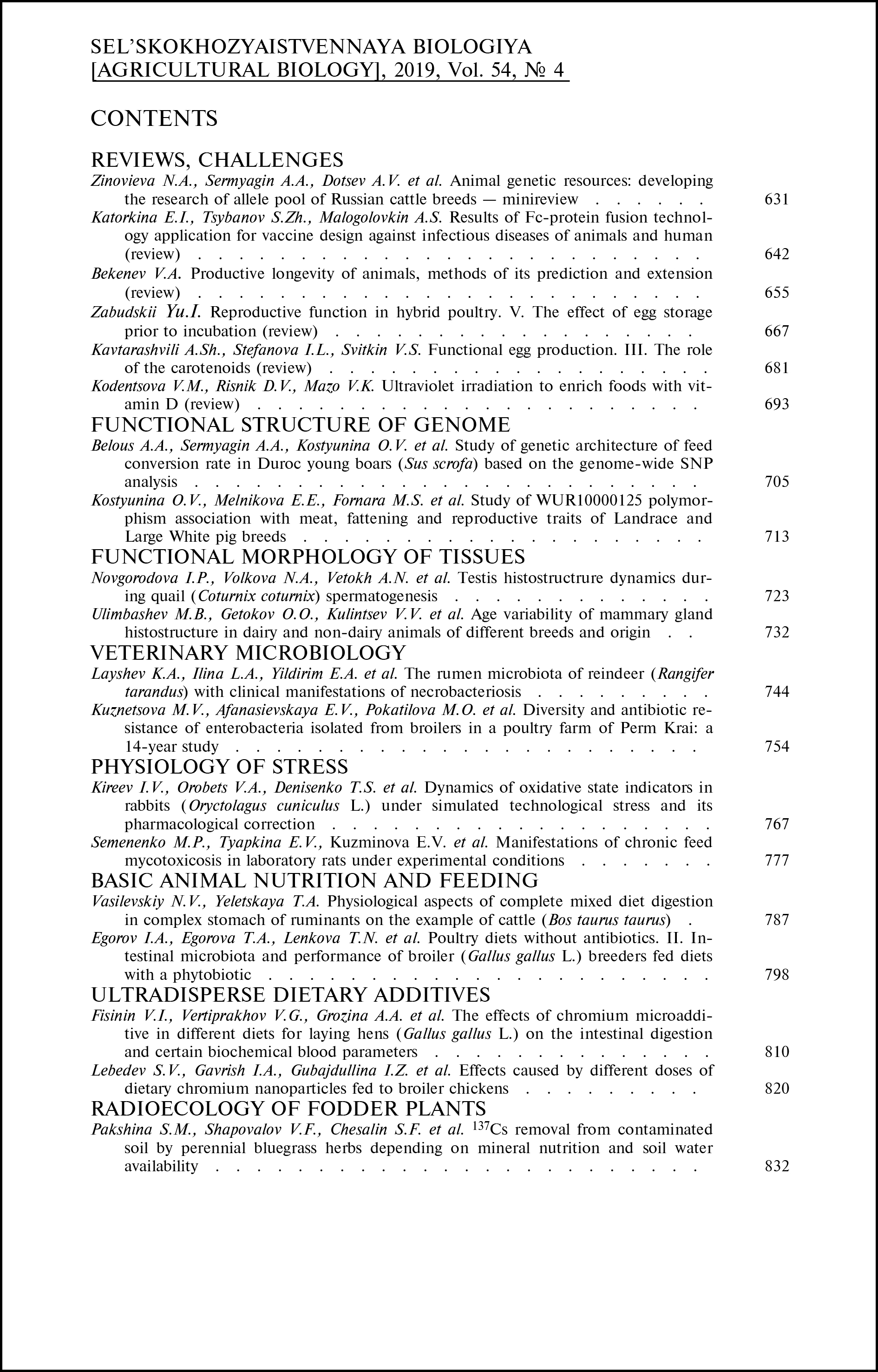doi: 10.15389/agrobiology.2019.4.832eng
UDC: 633.2:581.1:54.027:631.4
137Cs REMOVAL FROM CONTAMINATED SOIL BY PERENNIAL BLUEGRASS HERBS DEPENDING ON MINERAL NUTRITION AND SOIL WATER AVAILABILITY
S.M. Pakshina1, V.F. Shapovalov1, S.F. Chesalin1,
E.V. Smolskiy1, V.B. Korenev2
1Bryansk State Agrarian University, 2а, ul. Sovetskaya, p. Kokino, Vygonicheskii Region, Bryansk Province, 243365 Russia, e-mail pakshina_s_m@mail.ru (✉ corresponding author), sch.vf@yandex.ru, chesalinsf@icloud.com, sev_84@mail.ru;
2Novozybkovskaya Agricultural Experimental Station — Brunch of Federal Williams Research Center for Fodder Production and Agroecology, 6, Experimental Station, Novozybkov,Bryansk Province, 243020 Russia, e-mail korenevvb@yandex.ru
ORCID:
Pakshina S.M. orcid.org/0000-0002-4911-4653
Smolskiy E.V. orcid.org/0000-0002-7534-5893
Shapovalov V.F. orcid.org/0000-0003-2050-7768
Korenev V.B. orcid.org/0000-0003-1272-6469
Chesalin S.F. orcid.org/0000-0001-5668-2301
Received July 15, 2018
The expansion of zones of anthropogenically affected agricultural lands and soil pollution pose a serious environmental threat. Radionuclides with long half-lives of fallout from the anthropogenic nuclear disasters are among the most dangerous pollutants. At present, the world scientific literature has accumulated extensive data on the effect of ameliorants, organic and mineral fertilizers on the yield and biological removal of 137Cs from the soil by crops. This paper is our first report on the influence of natural and anthropogenic factors on 137Cs migration from the contaminated soil to bluegrass forage plants many years following the Chernobyl accident (South-West of the Bryansk region, 2009-2011). Our subjective was to study 137Cs removal from the soil depending on plant species and doses of full fertilizers. The soil of the site was alluvial meadow sandy, with pHKCl = 5.2-5.6, 3.08-3.33 % humus, 620-840 mg/kg mobile phosphorus, 133-180 mg/kg exchangeable potassium, and 137Cs contamination of 493-872 kBq/m2. Effects of N90P60K90, N90P60K120, N90P60K150, N120P60K120, N120P60K150, and N120P60K80 used as ammonium nitrate, granulated superphosphate, and potassium chloride on monospecies crops of perennial bluegrasses Dactylis glomerata L., Festuca pratensis Huds.,and Phalaroides arundinacea L. were compared. Fertilizers were used annually, with N and K applied in equal amounts at the first and second mowing and P full dose applied at the first mowing and P full dose applied at the first mowing. The period of vegetation in 2010 was characterized by increased radiation balance. In 2011, bioclimatic conditions were optimal for plant growth and development. The period between the first and the second mowing differed from that before the first mowing in the increased radiation balance and evaporability. The deficiency of soil moisture during the time from beginning of plant growth to the first mowing did not affect water supply of plants because of close groundwater after periodic flooding of the plain. We determined transpiration, transpiration coefficient, a relative transpiration, the rate of decrease in 137Cs specific activity of the biomass, intensity of 137Cs removal from the soil to justify an inverse relationship of 137Cs specific activity in the biomass from a dose of full mineral fertilizer. It has been shown that the intensity of 137Cs bio-removal depends on a dose of full mineral fertilizer. The intensity of 137Cs removal is the smallest in Dactylis glomerata and the greatest in Phalaroides arundinacea. The main mechanism of biological removing 137Cs from the soil is relative transpiration which determines the availability of soil moisture for plant roots and Pe value reflecting the ratio of diffusion and convection in the moisture flow. The relationship between Pe and relative transpiration in the three studied bluegrass species is high (r = 0.8-0.9). We propose the equation of 137Cs bio-removal by perennial bluegrass with the use of mineral fertilizers, which expresses essential pattern of 137Cs activity in the biomass as influenced by the fertilizers and is fair for the studied species of bluegrass herbs.
Keywords: alluvial meadow sandy soil, 137Cs, removal rate, perennial bluegrass herbs, transpiration, relative transpiration, NPK fertilizers.
REFERENCES
- Losvik M.H. Phytosociology and ecology of old hay meadows in Hordaland, western Norway in relation to management. Vegetatio, 1988, 78: 157-187 CrossRef
- Wallin L., Svensson B.M. Reinforced traditional management is needed to save a declining meadow species. A demographic analysis. Folia Geobotanica, 2012, 47: 231-247 CrossRef
- Vogl C.R., Vogl-Lukasser B., Walkenhorst M. Local knowledge held by farmers in Eastern Tyrol (Austria) about the use of plants to maintain and improve animal health and welfare. Journal of Ethnobiology and Ethnomedicine, 2016, 12(1): 40 CrossRef
- Zhu Y.G., Shaw G. Soil contamination with radionuclides and potential remediation. Chemosphere, 2000, 41(1-2): 121-128 CrossRef
- Uchida S., Tagami K. Comparison of radiocesium concentration changes in leguminous and non-leguminous herbaceous plants observed after the Fukushima Daiichi Nuclear Power Plant accident. Journal of Environmental Radioactivity, 2018, 186: 3-8 CrossRef
- Alexakhin R., Geras’kin S. 25 years after the accident at the Chernobyl nuclear power plant: radioecologycal lessons. Radioprotection, 2011, 46: 595-600 CrossRef
- Fesenko S., Jacob P., Ulanovsky A., Chupov A., Bogdevich I., Sanzharova N., Kashparov V., Panov A., Zhuchenko Yu. Justification strategies in the long term after the Chernobyl accident. Journal of Environmental Radioactivity, 2013, 119: 39-47 CrossRef
- Prosyannikov E.V., Silaev A.L., Koshelev I.A. Specific ecological features of 137Cs behavior in river floodplains. Russian Journal of Ecology, 2000, 31(2): 132-135 CrossRef
- Penrose B., Beresford N.A., Crout N.M.J., Lovatt J.A., Thomson R., Broadley M.R. Forage grasses with lower uptake of caesium and strontium could provide ‘safer’ crops for radiologically contaminated areas. PLoS ONE, 2017, 12(5): e0176040 CrossRef
- Jacob P., Ulanovsky A., Fesenko S., Bogdevitch I., Kashparov V., Lazarev N., Zhurba M., Sanzharova N., Isamov N., Panov A., Grebenshikova N., Zhuchenko Y. Rural areas affected by Chernobyl accident: Radiation exposure and remediation strategies. The Science of the Total Environment, 2009, 408(1): 14-25 CrossRef
- Sychev V.G., Lunev V.I., Orlov P.M., Belous N.M. Chernobyl': radiatsionnyi monitoring sel'skokhozyaistvennykh ugodii i agrokhimicheskie aspekty snizheniya posledstvii radioaktivnogo zagryazneniya pochv (k 30-letiyu tekhnogennoi avarii na Chernobyl'skoi AES) [Chernobyl: monitoring of cultivated land radioactivity and agrochemical aspects of mitigation of soil radioactive contamination (to the 30th anniversary of the technogenic accident at the Chernobyl nuclear power plant)]. Moscow, 2016 (in Russ.).
- Podolyak A.G., Timofeev S.F., Grebenshchikova N.V. Rekomendatsii po ispol'zovaniyu zagryaznennykh radionuklidami poimennykh zemel' Belorusskogo Poles'ya [Recommendations for the use of floodplain lands contaminated by radionuclides in Belarusian Polesie]. Gomel', 2001 (in Russ.).
- Hirayama T., Takeuchi M. Keitoku S. Relationship between radiocesium concentrations of soybean (Glycine max (L.) Merr.) seeds and shoots at early growth stages. Soil Science and Plant Nutrition, 2015, 61(1): 152-155 CrossRef
- Tsukada H., Hasegawa H., Hisamatsu S., Yamasaki S. Transfer of 137Cs and stable Cs from paddy soil to polished rice in Aomori, Japan. J. Environ. Radioact., 2002, 59: 351-363 CrossRef
- Sychev V.G., Belous N.M., Smol'skii E.V. Plodorodie, 2012, 1: 2-4 (in Russ.).
- Korenev V.B., Vorob'eva L.A., Belous I.N.. Vestnik Bryanskoi GSKHA, 2013, 5: 3-6 (in Russ.).
- Belous N.M., Smol'skii E.V., Chesalin S.F., Shapovalov V.F. Potassium fertilizers to reduce 137Cs accumulation and increase fodder crop harvesting on the radionuclide-polluted floodplain pastures. Sel'skokhozyaistvennaya biologiya [Agricultural Biology], 2016, 51(4): 543-552 CrossRef
- Kang D.J., Tazoe H., Ishii Y., Isobe K., Higo M., Yamada M. Effect of fertilizer with low levels of potassium on radiocesium-137 decontamination. J. Crop Sci. Biotechnol., 2018, 21(2): 113-119 CrossRef
- Belous I.N., Krotova E.A., Smol'skii E.V. Agrokhimiya, 2012, 8: 18-24 (in Russ.).
- Podolyak A.G., Bogdevich I.M., Ageets V.Yu., Timofeev S.F. Radiatsionnaya biologiya. Radioekologiya, 2007, 47(3): 356-370 (in Russ.).
- Kharkevich L.P., Belous I.N., Anishina Yu.A. Reabilitatsii radioaktivno zagryaznennykh senokosov i pastbishch [Rehabilitation of radioactively contaminated hayfields and pastures]. Bryansk, 2011 (in Russ.).
- Penman Kh. Krugovorot vody. Biosfera [The water cycle. Biosphere]. Moscow, 1972 (in Russ.).
- Budyko M.I. Teplovoi balans zemnoi poverkhnosti [The thermal balance of Earth surface]. Leningrad, 1956 (in Russ.).
- Rukovodstvo gidrometeorologicheskim stantsiyam po aktinometricheskim nablyudeniyam [Guide for actinometric observations on hydrometeorological stations]. Leningrad, 1973 (in Russ.).
- Abakumova G.M., Gorbarenko E.V., Nezval' E.I., Shilovtseva O.A. Klimaticheskie resursy solnechnoi energii Moskovskogo regiona [Climatic resources of solar energy in the Moscow region]. Moscow, 2012. (in Russ.).
- Pivovarova Z.I. Radiatsionnaya kharakteristika klimata SSSR [Radiation characteristic of climate in the USSR]. Leningrad, 1977 (in Russ.).
- Moldau Kh., Ross Yu., Tooming Kh., Undla N. Geograficheskoe raspredelenie fotosinteticheski aktivnoi radiatsii (FAR) na territorii Evropeiskoi chasti SSSR [Geographical distribution of photosynthetically active radiation (PAR) in the European part of the USSR]. Moscow, 1963: 149-158 (in Russ.).
- Takeyasu M., Nakano M., Fujita H., Nakada A., Watanabe H., Sumiya S., Furuta S. Results of environmental radiation monitoring at the Nuclear Fuel Cycle Engineering Laboratories, JAEA, following the Fukushima Daiichi Nuclear Power Plant accident. Journal of Nuclear Science and Technology, 2012, 49(3): 281-286 CrossRef
- Cramer M.D., Hoffmann V., Verboom G.A. Nutrient availability moderates transpiration in Ehrharta calycina. New Phytologist, 2008, 179: 1048-1057 CrossRef
- Matimati I., Verboom G.A., Cramer M.D. Nitrogen regulation of transpiration controls mass-flow acquisition of nutrients. J. Exp. Bot., 2014, 65(1): 159-168 CrossRef
- Genkel' P.A. Fiziologiya rastenii. M., 1975.
- Fuhrmann M., Lasat M.M., Ebbs S.D., Kochian L.V., Cornish J. Uptake of cesium-137 and strontium-90 from contaminated soil by three plant species; application to phytoremediation. J. Environ. Qual., 2002, 31(3): 904-909.
- Fuhrmann M., Lasat M., Ebbs S., Cornish J., Kochian L.Uptake and release of cesium-137 by five plant species as influenced by soil amendments in field experiments. J. Environ. Qual., 2003, 32(6): 2272-2279.
- Fesenko S.V., Balonov M.I., Voigt G., Alexakhin R.M., Sanzharova N.I., Panov A.V., Bogdevitch I.M., Howard B.J., Kashparov V.A., Zhuchenko Y.M. An extended critical review of twenty years of countermeasures used in agriculture after the Chernobyl accident. The Science of the Total Environment, 2007, 383(1-3): 1-24 CrossRef
- Alexakhin R.M., Sanzharova N.I., Spiridonov S.I., Panov A.V., Fesenko S.V. Chernobyl radionuclide distribution, migration, and environmental and agricultural impacts. Health Physics, 2007, 93(5): 418-426 CrossRef












